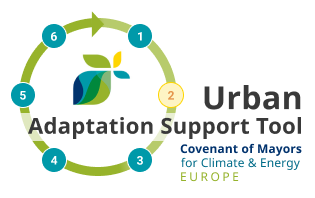
Assessing climate change risks and vulnerabilities
2.2 Understanding climate projections and future impacts
Future climate and impact projections
At the European scale, the EEA produces numerous indicators of observed and projected climate change and its impacts, for example temperature, precipitation, droughts, wildfires or sea level rise. The EEA Report Climate change, impacts and vulnerability in Europe 2016 – an indicator-based assessment provides a useful overview of climate change and its impacts in Europe. Furthermore, Copernicus Climate Change Service provides climate data for policy makers to support planning and decision making on climate change at the national, regional and city scale in Europe.
The Climate-ADAPT country pages provide links to national risk and vulnerability assessments of the individual countries, which tend to include climate change projections. Many of the EU-funded research and knowledge projects have been concerned with providing downscaled climate projections for a given location (see EU-funded projects below).
Developed specifically for European cities, the Urban Adaptation Map Viewer provides an overview of the current and future climate hazards, the vulnerability of the cities to these hazards and their adaptive capacity. The map viewer collates information from various sources on the observed and projected spatial distribution and intensity of high temperatures, flooding, water scarcity, wildfires and vector-borne diseases. It also provides some information on the causes of cities’ vulnerability and exposure to these hazards, linked to the characteristics of cities and their population.
More information about projected global climate changes and the impacts on cities can be found in the reports of the Intergovernmental Panel on Climate Change (IPCC), for example Chapter 8: Urban Areas in the IPCC Fifth Assessment Report or the IPCC Global Warming of 1.5°C report.
Interpreting the projections
The important elements of climate projections to consider are:
- The spatial scale of the projections, as different climate models use different spatial resolutions;
- The baseline period, from which the change is modelled (e.g. relative to 1986-2005);
- The projection timeline, usually expressed as a period (e.g. 2081-2100 or 2020 – 2052);
- The underpinning greenhouse gases emissions or other scenarios. For example, in the IPCC Fifth Assessment Report, RCP stands for Representative Concentration Pathway and reflects the amount of greenhouse gases in the atmosphere, according to four different scenarios (of which RCP 2.6 represents the lowest and RCP 8.5 the highest concentrations);
- How the projected change is represented. Climate change projections tend to state the probability of something happening in the future or outline a range of possible outcomes in terms of future temperatures, rainfall or sea level rise. This is because the future climate will be affected by the level of greenhouse gas emissions and other socio-economic developments. Also, climate projections are derived from various models (mathematical representations of the climate developed on global or regional scales), which are constantly improved but still cannot predict the future with absolute certainty.
The uncertainty of the future climate may be difficult to understand, plan for, or communicate to others. Climate-ADAPT provides uncertainty guidance, covering the following topics:
Dealing with uncertainty in adaptation planning can be addressed by investing in flexible, low-regret adaptation actions (see Step 4.3), which also provide additional benefits, such as reduction of greenhouse gases emissions (see Step 5.4), and thus can be justified despite the uncertainty associated with future climate scenarios. Guidance on dealing with uncertainty and complexity is also provided by the RESIN project.
